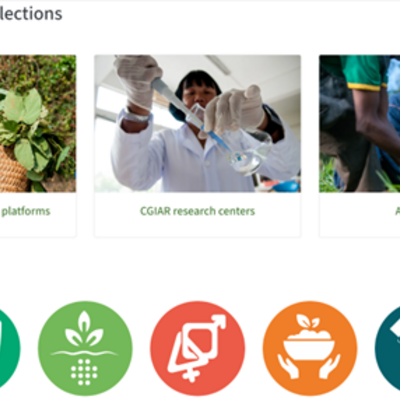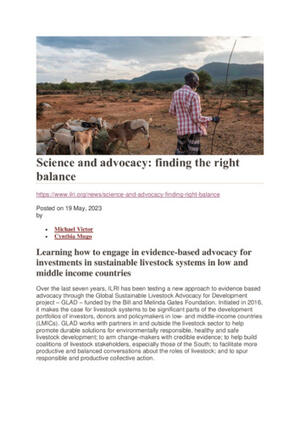
Building a communication framework for CGIAR, the power of the ‘development multiplier’ and ‘KM inside’…
Communication, knowledge management, advocacy, public relations, engagement, it’s easy to lose your latin when trying to find out what this all means and what it all can do for you and your CGIAR Research Program (CRP) or your work generally.
This confusion explains perhaps why the first guidance note for the CRP pre-proposals – developed for the second phase of CRPs – mentioned the word ‘communication’ twice in 54 pages, and not necessarily to explain what to do about communication.

Participants of the Rome meeting on communication and partnership (photo credit: E. Le Borgne / ILRI)
This is why a group of people gathered in Rome four weeks ago, under the auspices of the CGIAR Consortium Office. Their objective was two-fold. The first objective was known beforehand, while the second one dawned on all participants early on in the workshop:
- To help draft some guidance notes on communication and partnerships for the full CRP proposals.
- To make sense of ‘communications‘ across CGIAR and progressively develop a ‘communications framework’ that all people working on communication, knowledge management and related fields can relate to, in a similar fashion to the CGIAR capacity development framework.
This effort built upon previous efforts from across the different CGIAR families of communications (e.g. the Heads of communication at CGIAR centres, the KMC4CRP group, the knowledge management (KM) group, the wider CGIAR communication group). Two of these past efforts really stood out:
- The Montpellier commitment which the heads of communication at CGIAR centres put together a couple of years ago as an effort to explain what communication stands for in CGIAR work;
- The recent series of briefs that the Knowledge Management for CGIAR Research Programs (KMC4CRP) informal group put together in May 2015 in Addis Ababa to align the work of CRP comms and KM specialists and capitalise on all the good ‘KMC’ work done in the first phase of CRPs.
But these two did not really manage to rally all comms and KM people across CGIAR. And this is why three significant outcomes of this Rome meeting are worth noting:
All comms together!
The small group of participants in Rome spanned partnerships, KM, corporate communication and the Consortium office. All major families of ‘Communications’ were represented.
The group undertook a systematic, if light, review of all the previous events and processes that have had some significance for communications within CGIAR. In doing so, they tried to bring the best that all comms families of CGIAR have ever contributed.
And most importantly, in addition to some ideas to influence the guidance note for developing full CRPs, the Rome meeting participants started sketching a communications framework that tries to make sense of all areas of communications work – whether done by comms specialists or supported by them. The framework highlighted six – now seven – domains as key areas which hopefully cover most aspects of the comms families:
- Communicating with and for actors on the ground to scale out technologies and practices
- Communicating and knowledge sharing for policy influence to scale up results
- Communicating about the program, the science and the results throughout the CRP lifecycle
- Communicating and engaging for effective partnerships
- Learning and sharing to improve collaboration among scientists within and across CRPs
- Communicating about cross cutting issues and their contribution to achieving outcomes (gender and youth, climate change, capacity development, policy and institutions)
- And finally, to this was added specifically ‘CGIAR communications for public awareness, donor relations, fund-raising’
Now the time is ripe to inspect these domains with all the people across the CGIAR comms families and to improve that framework, and make sure that the KMC4CRP briefs are naturally mapped onto this framework.
The power of the ‘development multiplier’
CGIAR is a research consortium. But CGIAR research is not research for the sake of it, it is research for development, perhaps even research in development as advocated by the Aquatic Agricultural Systems research program.
What is key to ensure that research gets put ‘into use’ and leads to genuine development outcomes is a mixture of approaches that focus on interactions between the research (and researchers) and the environment they wish to influence. These approaches form a ‘development multiplier’ and include e.g. institutional arrangements, partnerships, capacity development and communications.
Not investing in communications – or at least not considering them – is a likely way to lose some of the potential of research to multiply developmental outcomes.
KM inside?
Finally, as a smaller aside, knowledge management is not very visible in the language of the communications framework. As a result, as CIAT’s Simone Staiger wrote in a recent blog post, knowledge sharing is trying to find a home. But in spirit, knowledge management is part and parcel of the communications framework. If we take one definition that KM is information management + knowledge sharing + learning, then:
- Information management is embedded in all seven areas, as perhaps more of a ‘back office’ function and set of practices but that are nevertheless vital for long term visibility, availability and sustainability of the CRP activities and results;
- Knowledge sharing is present in the engagement mentioned specifically in two areas of the framework (Communicating and engaging for effective partnerships; Learning and sharing to improve collaboration among scientists within and across CRPs) but also all other areas in lighter ways;
- Learning is particularly present in the development partnerships and in the scientific partnerships highlighted in the same two areas mentioned above.
The communication framework is not perfect, but it provides an opportunity for comms and KM people across the CGIAR to align their work. That process will be long, will be slow, but as the saying has it:
If you want to go fast, go alone.
If you want to go far, go together.


















